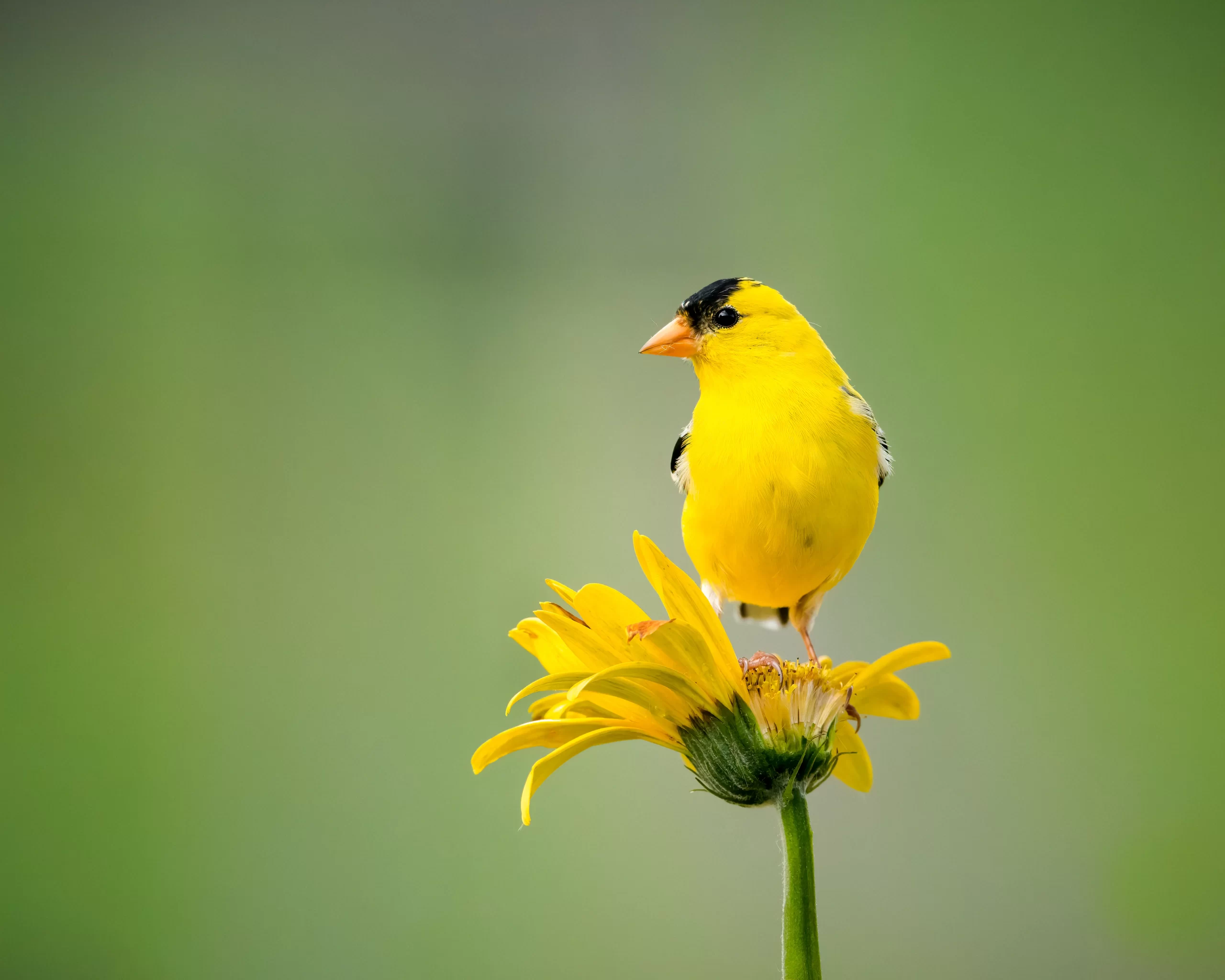Ohio does not have the finch diversity of some states in the Upper Midwest, but the finches in Ohio are nothing to scoff at. There are nine Ohio finches that are readily found in the state. Let’s discuss some general considerations about the types of finches in Ohio.
First, residents of the Buckeye State will be pleased to hear that all Ohio finches will visit bird feeders. Now, some species are far more likely to visit a bird feeder compared to others. However, be sure to keep your eyes peeled – you never know what will appear.
Next, know that all species of Ohio finch are naturally social. This means that they are often found associating in groups with one another. Some finches that live in Canada and the upper Midwest may wander further south than usual during certain years as they look for food. These occurrences are known as “irruptions”.
Finally, although you may want to attract finches to nest in your yard, know that they will not nest in birdhouses. If you put up a birdhouse with the intention of attracting a finch, you will likely only host House Sparrows.
With all that said, it’s time to discuss the different types of Ohio finches. Keep reading to discover all you wish to know about Ohio finches!
Table of Contents
9 Finches In Ohio
American Goldfinch

American Goldfinches are the most numerous and recognizable Ohio finches. These small Ohio yellow finches are abundant year-round residents in the state. They are a favorite among backyard birders they frequent residential areas and commonly visit bird feeders.
American Goldfinches are around for the entirety of the year in Ohio. Many Ohioans look forward to seeing the dazzling yellow and black feathers of a male during the summer. Of course, these wonderful creatures molt into more muted colors during the winter, but they are nonetheless around all year.
Finding a goldfinch in Ohio is not difficult. Offering thistle, nyjer, or sunflower seeds will surely attract them to your yard at some point. If attracting them to your yard takes a while, try looking for American Goldfinches on neighborhood walks, at parks, or in weedy, overgrown areas.
Common Redpoll

Common Redpolls are tiny finches of the arctic tundra. These small songbirds are spotted annually in Ohio, though some years may produce only a handful of records. However, during irruption years, sizable flocks of Common Redpolls may wander into the state.
The small size and subtle plumage of Common Redpolls make them easy to overlook. Fortunately, they often travel in flocks and stop by bird feeders. Here, a hungry flock can quickly deplete feeders of their bird seed.
When not at bird feeders, look for Common Redpolls in trees with small seeds or fallow fields that contain plenty of seeds. These finches depart for their breeding grounds in Canada in March or April.
Evening Grosbeak

Evening Grosbeaks are among the most awe-inspiring finches in Ohio. They are large, colorful finches with sweet calls and calm mannerisms.
Ohio is fortunate to have Evening Grosbeaks show up annually. They do not breed in the Buckeye State, rather, small numbers spend the winter. They are never common, and an Evening Grosbeak usually attracts an audience of birders when one is located.
Backyard bird feeding stations are among the best places to find these voracious finches. Of course, parks and wildlife areas that offer seeds are great places to check as well. When not at a bird feeder, Evening Grosbeaks may be found in fruiting trees or pines.
Hoary Redpoll

Hoary Redpolls are the most uncommon Ohio finch on this list. This tiny, pale finch in Ohio has been reported to eBird fewer than 200 times in Ohio.
Hoary Redpolls look very similar to Common Redpolls, making it difficult to distinguish between them. However, knowing that Hoary Redpolls are pale with less streaking can help with identification.
There are few instances in which Hoary Redpolls will not be with a group of Common Redpolls when visiting Ohio. Indeed, they often blend seamlessly into a redpoll flock, so be sure to have diligence when examining these birds. Look for Hoaries in the same locations in which Common Redpolls may be found.
House Finch

House Finches are abundant in the state of Ohio, being the only finches that breed in Ohio aside from American Goldfinches. Like goldfinches, House Finches have become well adapted to human settlements, as they often thrive in residential areas.
The songs of House Finches are regarded by some as an indicator that spring has arrived. House Finches are common on farmsteads and urban environments, but they avoid large tracts of forest.
Simply installing a bird feeder and filling it with seeds is often enough to attract House Finches to a yard. If a pair really enjoys your yard, they may stick around and build a nest in a shrub during the breeding season. However, keep in mind that these birds look very similar to House Sparrows.
Pine Siskin

Pine Siskins are regulars in Ohio, being one of the more numerous finches to visit the state. Indeed, during the winter, sizable flocks of siskins may arrive and frequent bird feeders or groves of pine trees.
Several records of Pine Siskins in the summer are submitted to eBird annually in Ohio, and some breeding has been observed. However, the vast majority of Pine Siskins depart from Ohio and head north to breed in boreal forest.
When Pine Siskins arrive in Ohio during the fall, they seek out locations that have ample food sources. Therefore, cemeteries, backyards, fallow fields, and suburban neighborhoods are all good locations to check for these creatures.
Purple Finch

Purple Finches are attractive, cheerful finches in Ohio. They are beloved by Buckeyes for their attractive colors and the wonderful songs that males sing during the spring and summer. Although they are relatively common, beware of the similar-looking House Finch and make sure you can separate the two species.
Purple Finches breed in Ohio, but their breeding range is restricted to the northeastern quarter of the state. While the remainder of the state does not host breeding Purple Finches, there are plenty that frequent all parts of Ohio during the winter.
This Ohio finch is no stranger to feeding at bird feeders, but they also enjoy finding a good patch of shrubs where they can seek shelter and consume berries. Thickets of juniper or invasive honeysuckle are often where they can be found.
Red Crossbill

Red Crossbills are a captivating finch that is somewhat of a rarity in Ohio. The state typically sees several dozen records of these finches annually, but they are unpredictable and can be difficult to find.
However, once a group of Red Crossbills are found, they may stay in a location for several days or even weeks if the food is good enough. Red Crossbills do not breed in Ohio, but two breeding populations are rather close to the state. One is in the Appalachian Mountains to the east, while the other is in the boreal forest of Michigan and Canada to the north.
Red Crossbills from all over seem to visit Ohio. Indeed, the state gets crossbills from the Appalachians, the northern boreal forest, and even birds that breed more than 1,000 miles to the west. Look for crossbills in cemeteries and other areas with mature conifers.
White-winged Crossbill

White-winged Crossbills are more regularly observed in Ohio compared to their red relatives, however, they are still not common.
No summer breeding records of this Ohio finch exist, but White-winged Crossbills travel to Ohio in the winter in decent numbers. They seldom visit feeders, so they are not as easy to find as other types of finches in Ohio.
Look for White-winged Crossbills in the same places that Red Crossbills would frequent. Established neighborhoods with conifers, cemeteries, and windbreaks may all be good places to check.

